Access to a variety of AP Inter 2nd Year Sanskrit Model Papers Set 5 allows students to familiarize themselves with different question patterns.
AP Inter 2nd Year Sanskrit Model Paper Set 5 with Solutions
Time : 3 Hours
Max.Marks : 100
Note :
- All questions should be attempted.
- Question Nos. 1, 2 and 3 should be answered either in the medium of instructions of the candidate or in Sanskrit (Devanagari Script) only.
- The remaining questions should be answered in Sanskrit (Devanagari Script) only.
सूचना :
प्रथम, द्वितीय, तृतीय प्रश्नान् विहाय अन्ये सर्वेऽपि प्रश्नाः संस्कृत भाषायामेव समाधातव्याः ।
1. एकस्य श्लोकस्य प्रतिपदार्थं भावं च लिखत
अ) तक्षकस्य विषं दन्ते मक्षिकायास्तु मस्तके ।
वृश्चिकस्य विषं पुच्छे सर्वाङ्गे दुर्जने विषम् ॥
समाधान:
समा. पदच्छेद (Word Division) : तक्षकस्य, विषं, दन्ते, मक्षिकायाः, मस्तके, वृश्चिकस्य, विषं, पुच्छे, सर्वाङ्गे, दुर्जने, विषम् ।
अन्वयक्रम : तक्षकस्य, विषं, दन्ते, मक्षिकायाः, मस्तके, वृश्चिकस्य, पुच्छे, विषं, दुर्जने, सर्वाङ्ग, विषम् ।
अर्थ (Meanings) : तक्षकस्य = to a serpent, विषम् = poison, दन्ते in fangs, मक्षिकायाः = to a bee or spider, मस्तके = in head (poison), वृश्चिकस्य = to a scorpion, पुच्छे = in tail, विषम् = poison, दुर्जने = to an evil person, सर्वांगे = throughout the body; विषम् = poison.
भाव (Substance) : A serpent has poison is its fangs, a bee has in its head, and a scorpion has poison in its tail. But an evil person has poison in his whole body.
आ) परोपदेशसमये जनाः सर्वेऽपि पण्डिताः ।
तदनुष्ठानसमये मुनयोऽपि न पण्डिताः ॥
समाधान:
पदच्छेद (Word Division) : परोपदेशसमये, जनाः, सर्वेः, अपि, पण्डिताः, तत्, अनुष्ठानसमये, मुनयः, अपि, न, पंडिताः ।
अन्वयक्रम : सर्वे जनाः, अपि, परोपदेशसमये, पण्डिताः, तत्, अनुष्ठानसमये, मुनयः, अपि, न पण्डिताः ।
अर्था (Meanings) : पर + उपदेशसमये = while advising others; सर्वे अपि = all the; जनाः = people; पंडिता: = are scholars; तत् + अनुष्ठानसमये = while putting into practice; मुनयः अपि = even the sages; न पण्डिताः = are not scholars.
(Substance): While giving advice to others, everyone acts as a scholar, but while putting it into practice, even the sages are not scholars.
2. एकं निबन्धप्रश्नं समाधत्त ।
अ) रावणाय विभीषणेन कृतमुपदेशं लिखत ।
Answer:
Introduction: The lesson Vibhishanopadesa is an extract from the Yuddhakanda of the Ramayana, written by Valmiki. Vibhishana advises Ravana to send Sita to Rama.
The Advice of Vibhishana: Vibhishana advised Ravana that one should use their might only when the three other methods namely sama, dana and bheda fail. Then also it would work again the weak and already unfortunate enemies. They should not underestimate the enemy. परेषां सहसावज्ञा न कर्तव्या कथञ्चन | They should protect lives. They need not have an unnecessary fight with one who followed Dharma. Sita should be sent to Rama.
Vibhishana advised Ravana to abandon his anger which would destroy his comfort and dharma. Ravana should follow dharma which would increase joy and fame.
The Inauspicious signs: Vibhishana mentioned the various inauspicious signs witnessed since the arrival of Sita. “The milk of the cows has decreased. The mighty elephants have lost their rut. The horses are neighing piteously. The donkeys, camels and mules are shedding tears losing their hair. Flocks of crows are cawing harshly on all sides. Cruel animals have assembled at the gates of the city, and are roaring loudly.”
He compared Sita with a serpent. She had the hood of bosom, poison of worry, fangs of smile, heads of five fingers and a great body. He warned that Ravana would not be spared with life by Rama. Even the Sun, Indra, Yama and other could not protect him.
Friends, who were like enemies : Vibhishana accused the Rakshasas saying that they were enemies in the guise of friends. He said that a minister should weight the strength, loss and gain on both sides, and give a beneficial advice. वदेत् क्षमं स्वामिहितं मन्त्री । He asked whether anyone could stand before the arrows of Rama. He advised that Sita should be sent to Rama along with precious gifts.
When Ravana said that he would not have spared if this speech was made by any other person, Vibhishana became angry. He flew in to the space, and said that as a brother Ravana could say anything, but he would not forgive him. He said that people who spoke sweetly could be found easily. But those who gave bitter but beneficial advice, and its listener were hard to be found. अप्रियस्य च पथ्यस्य वक्ता श्रोता च दुर्लभः | He wished him happiness, and left.
![]()
आ) मातृभूमेः वैभवं कविः कथं प्रशशंस ?
Answer:
Introduction: The lesson Sa Matrubhumirmama was written by Dorbala Prabhakara Sarma. The poet describes the great ness of India in this poem.
Vedabhumi, Jnanabhumi and Dharmabhumi: The poet praises the motherland as a land of Vedas, wisdom, languages, gods, dharma, action, yoga, tapas, rivers, holy places and great people. Here, the cattle of the Vedas show the right path.
The people here are cultured, intelligent, healthy and sweetly speaking. यत्रैताः हृदि जागृताः प्रकृतयः सा मातृभूमिर्मम | The land is prosperous, waters are pure, breeze is purifying and life is friendly. There are Rik mantras that praise the gods, Yajush mantras that are used in sacrifices, Atharva mantras that show the path of prosperity. This land is full of knowledge with the Vedas, Upanishads, Puranas, Itihasas, Kavyas etc. विद्या यत्र परोपकारविभवाः सा ज्ञानभूमिर्मम | There are different languages belonging to Vanga, Anga, Andhra, Kerala, Maharashtra, Sindhi, Gujarati, Karnataka etc.
Selfless People: The gods of rivers, villages, cities, towns, households, lands and others bestow boons. The lords of quarters such as Indra, Agni, Varuna, Vayu, Kubera, Yama etc. along with Vishnu, Uma and others grant welfare to the people. In a household, the mother takes care of the interests of her husband and children, father works, brothers give relief, teachers preach and the elders offer advice. ग्रमे यत्र गृहे समैक्यपरता सा धर्मभूमिर्मम | The people work selflessly, are engaged in meditation, prayers and contemplation. The wisdom of the sages ensures the welfare of the world, strengthens culture and enriches the knowledge.
Rivers and holy places: Rivers like Ganga, Yamuna, Saraswati, Godavari, Krishna, Narmada etc. remove sins, diseases and obstacles. Mountains such as Hemadri, Rajatadri, Aravali, Mahendra, Himalayas, Sahya etc. embellish this land. There are holy cities such as Kasi, Ayodhya, Puri, Kanchi, Madhura, Avanti, Tirupati, Ahobilam etc. Great sages and poets like Vyasa, Valmiki, Bhrigu, Sankara, Kalidasa, Bhavabhuti etc. belonged to this land.
3. एकं निबन्धप्रश्नं समाधत्त ।
अ) “मन्दविषसर्पकथा” इति पाठ्यभागस्य सारांशं लिखत ।
Answer:
Introduction: The lesson Mandavishasarpakatha is an extract from the Hitopadesa written by Narayana Pandita. This tells the story of an old serpent that devoured the frogs making friendship with them.
The old serpent: There was a serpent named Mandavisha in a ruined forest. Because of its old age, it became unable to search for food, and remained on the bank of a pond. A frog asked him why he did not take food. Then the serpent told his story.
Kapila’s advice: Once Mandavisha had bitten the son of Kaundinya, a Brahmin from Brahmapura. When the father was crying rolling on the ground, an educated Brahmin Kapila advised him not to weep like that. He said. “Death is certain for those who are born, and birth is certain for those dead. Death is certain, now or hundred years after मृत्युर्वै प्राणिनां ध्रुवः | Death approaches nearer and nearer day by day. One will not have permanent association with anything, even with his body. “On hearing that, Kaundinya decided to retire to the forests. But Kapila objected to it, saying that there would be evils even in a forest. To the detached one, the
house itself would be a hermitage. निवृत्तरागस्य गृहं तपोवनम् | He said that there was pain only, and not happiness in the world.
Kapila advised Kaundinya to renounce all the associations. If it was not possible, he should associate with the good only. Hi सङ्गो हि भेषजम् | Then the Brahmin cursed the serpent to become a vehicle of the frogs. Hence, Mandavisha arrived there.
Killing the frogs: When the frog informed this to their king, he came and rode on the back of the serpent for some time. The next day, the frog-king permitted the serpent to have the frogs as his food, as he was weak. Then the serpent killed all the frogs · one by one, and at last ate the frog-king too.
क्रमशः खादितवान् । मण्डूकनाथमपि भक्षितवान् ।
जातस्य हि ध्रुवो मृत्युः
थ्रुवं जन्म मृतस्य चः
अपि स्वेन शरीरेण
किमुतान्येन केननित् ।
निवृत्तरागस्य गृहं तपोवनम्
सतां सङ्गो हि भेषजाम्
स्कन्धेनापि कहेत् शत्रून्
कार्यमासाद्य बुहिमान्
जातस्य हि ध्रुवो मृत्युः
ध्रुवं जन्म मृतस्य च
संभोगो हि वियोगस्य
संच्वचयति सम्भवम्
आ) अप्पय्यदीक्षितेन्द्र इति पाठ्यभागसारांशं संग्रहेण विवृणुत ?
Ans. Introduction: The lesson Appayyadikshitendra was written by Sanka Usharani. This lesson narrates the story of the great scholar and devotee Appayya Dikshita.
Family of scholars: Appayya Dikshita was born in the family of scholars. His father was Rangarajadhwari was a genius. His grandfather was in the court of Acchana Dikshita. Appayya was born in 1554 in Virinnchipura in Tamilnadu.
Appayya was a poet, philosopher, scholar, devotee, Grammarian, Mimamsaka, Logician, Ritualist etc. He studied all the fourteen branches of knowledge at the feet of his teacher Nrisimha Ramaswamy.
Marriage and works: A scholar named Ratnakheta Srinivasa wanted to defeat Appayya with the grace of the goddess Kamakshi. However, the goddess advised him to give his daughter in marriage to Appayya. अप्पय्यः असाधारणः वादे जेतुमशक्तः | He did so. Appayyà had two daughters and three son.
Many students came to him to receive education. Bhattoji Dikshita came to him to learn Mimamsa and Vedanta.
Appayya wrote 104 works on many subjects like Vyakarana, Vedanta, Alankara etc. Among the Vedanta works Siddhanta leasangraha and Parimala vyakhya were famous. Sivakarna mritam and Sivarchanachandrika were his famous works devoted to Siva. Kuvalayananda and Chitramimamsa were Alankara works.
Appayya was invited by Vellore Chinabommanayaka to adorn his court. Appayya was epileptic. But when the king came to his house to observe his disease, Appayya transferred his disease on to his upper garment. Dikshita means one who performed sacrifices. Appayya performed more than 104 sacrifices including Somayaga, Vajapeya etc. He even performed Viswajit. Once while he was performing a sacrifice, the king arrived there and offered him clothes, ornaments etc. Which he immediately put in the fire. The fire god appeared wearing them.
Devotion of Siva: Appayya was a devotee of Siva. To test his devotion, he ate dattura leaves and became mad. In that state, he recited Unmattapanchasat. The king honoured him with a shower of gold coins when Appayya completed his Sivarkamanidipika. राजा चं कनकाभिषेकेण सत्कृतवान् | Appayya built a temple for Siva with that gold in his native village. Though Appayya was a Tamilian he used Telugu idioms and proverbs. He praised Telugu language thus:
Being born in Andhra, knowing the language of Telugu, studying Prabhakara’s Mimamsa work, and belonging to the Yajurveda School are the fruit of not less penance.
Though the householder Appayya was in the path of action, his mind was in the path of detachment only. He spent his last days in the presence of Nataraja of Chidambara. He became one with Siva at the age of 72 in the year of 16261 He was considered the incarnation of Siva Himself. अप्पय्य: साक्षात् परमशिवस्य अवतारः ।
![]()
4. त्रयाणां प्रश्नानां समाधानानि लिखत ।
अ) कर्णभारं केन विरचितम् ?
समाधान:
कर्णभारं भासेन विरचितम् ।
आ) नृपश्रिय: कीदृशा: ?
समाधान:
नृपश्रियः भुजङ्गजिह्वाचपला ।
इ) बालानां कलहः कीदृश: ?
समाधान:
बालानां कलहः तत्कालीनः भवति । बालाः कलहायन्ते अनन्तरं क्रीडन्ते च ।
ई) द्रोणडुपदयोः सम्बन्धः कीदृश: ?
समाधान:
द्रोणद्रुपदयोः स्नेहबन्धः अच्छेद्यः अविभाज्यः च । सः पटुचिक्कणात्मकः अभवत् ।
उ) कालिदासश्लोके भोजेन प्राप्तं समाधानं किम ?
समाधान:
कालिदासश्लोकेन भोजेन प्राप्तं समाधानम् एवम् अस्ति द्वयोः सम्भाषणकर्त्रीः मध्ये सूचनां विना न प्रविशेत् इति ।
ऊ) कालिदासः महाराजं कथं सन्तोषितवान् ?
समाधान:
भोजस्य मनोगतस्य यथोचितम् उत्तरं दत्वा कालिदासः भोजं संतोषितवान् ।
5. द्वयोः ससंदर्भ व्याख्यानं लिखत ।
अ) वदेत् क्षमं स्वामिहितं मन्त्री ।
समाधान:
परिचयः एतत् वाक्यं विभीषणोपदेशः इति पाठ्यभागात् स्वीकृतम् । एषः पाठः रामायणस्यं युद्धकाण्डात् गृहीतः । अस्य कविः वाल्मीकिः ।
सन्दर्भः प्रदीयतां दाशरथाय मैथिली इति रावणं प्रति उपदिशन् विभीषणः एवं वदति ।
भावः परबलं, स्वबलं तथा क्षयं वृद्धिं च बुद्ध्या समीक्ष्य मन्त्री स्वामिहितं वदेत् ।
आ) राज्येन किं तद्विपरीतवृत्तेः प्राणैः उपक्रोशमलीमसैर्वाः ।
समाधान:
परिचयः एतत् वाक्यं ‘धर्मनिष्ठा’ इति पाठ्यभागात् स्वीकृतम्, एषःभागः कालिदासस्य रघुवंश महाकाव्ये पञ्चमसर्गात् स्वीकृतः ।
सन्दर्भः दिलीपः सिरं प्रति एवं वदति ।
भावः अक्षत्रविरुद्धवृत्तेः राज्येन किं प्रयोजनम् निन्दया मलिनयुतं प्राणेन किं प्रयोजनम् ।
‘विवरणम्ः क्षत्रियः राज्यं पालयति, स्वपराक्रमेन धर्म पालयति, आक्षितान् रक्षति ।
इ) विद्या यत्र परोपकारविभवाः सा ज्ञान भूमिर्मम ।
समाधान:
परिचयः – एतत् वाक्यं सा मातृभूमिर्मम इति पाठ्यभागात् स्वीकृतम् । अस्य कविः श्रीमान् दोर्बल प्रभाकर शर्मा ।
सन्दर्भः – मातृभूमेः वैशिष्ट्यं वर्णयन् मम मातृभूमिः ज्ञानभूमिः, धर्मभूमिः इति वदन् कविः एवं वर्णयति ।
भावः – यत्र वेदाः उपनिषदः, पुराणेतिहासाः आयुर्योगधर्मसंगीतग्रन्थाः च परोपकारविभवाः भवन्ति सा ज्ञानभूमिः मम मातृभूमिः इति कविः वदति ।
ई) सा संस्कृताख्या सुकृतैकलभ्या ।
समाधान:
परिचय : गतत् वाक्यं ‘नित्रविंशतिः’ इति पाठ्यभागात् स्वीकृतम्’ अस्य पाठ्यभागस्य रचयिता जटावल्लभपुरुषोत्तम शास्त्री |
सन्दर्भ : गीर्वाणवाण्याः वैभवं वर्णयनन् कविः एवं वदति । संस्कृतभाषा सुधास्रवन्ती, सुरभाषिता, सूच्चारिता, सूक्तिरन्नवार्धिः च ।
भाव : संस्कृतभाषा पुण्यैफलेन एव लभ्या ।
विवरणम् : संस्कृतभाषा अतिप्राचीना, सुधास्रवन्ती च सूक्तिरत्नै सुशोभिता ।
6. द्वयोः ससंदर्भ व्याख्यानं लिखत ।
अ) मृत्युर्वै प्राणिनां ध्रुवः ।
समाधान:
परिचयः एतत-वाक्यं, “मन्दविषसर्पकथा” इति पाठ्यभागात् स्वीकृतम् अस्य पाठ्यभागस्य रचयिता नारायणपण्डितः ।
सन्दर्भः पुत्रशोकं अनुभवन्तं कौण्डिन्यं कपिलः प्रति एवं अवदत् भावः सर्वेषां प्राणिनां मृत्युः निश्चयम्
विवरणम्ः जातस्य मरणं, मृतस्य जननं निश्चयम्, अतः सर्वेषां प्राणिनां मृत्युः ध्रुवम् ।
आ) यः कृतमुपकारं विस्मरति स एव पुरुषाधमः ।
समाधान:
परिचय : इदं वाक्यं “विक्रमस्य औदार्यम्” इति पाठ्यभागात् स्वीकृतम् । अस्य पाठस्य रचयित शिवदास ।
सन्दर्भ : राज्ञः वचनं क्षुत्वा एकः एवं अवदत् ।
भाव : यः कृतं उपकारं विस्मरति सः मानवः पुरुषाधमः भवति ।
विवरणम् : नारिकेल वृक्षः पीतं तोयं स्मृत्वा नरागां अमृततुल्यं जलं ददाति यः मानवः परैः कृतं उपकारं विस्मरति सः मानवः पुरुषाधमः भवति ।
![]()
इ) विवाहो नाम वणिग्व्यवहार एव ।
समाधान:
परिचयः वेङ्कटरावस्य भिषजो भैषज्यम् इति पाठ असित अस्य पाठस्य रचयित, श्री पुल्लेल श्रीरामचन्द्रः ।
सन्दर्भः एकः वृद्धः युवकं उद्दिश्य एवं अवदत् ।
भावः परिणयः नाम केवलं वाणिज्यव्यवहारः ।
विवरणम्ः सर्वस्य धनं प्रधानं, सर्वेगुणाः धनं आश्रयन्ति । तद्दत् विवाहः अपि केवलं वाणिज्यमेव ।
ई) राजा तं कनकाभिषेकेण सत्कृतवान् ।
समाधान:
परिचय : एतत् वाक्यम् अप्पय्यदीक्षितेन्द्र इति पाठ्यभागात् स्वीकृतम् । अस्य रचयित्री सङ्का उषाराणी ।
सन्दर्भ : अप्पय्यदीक्षितः शिवार्कमणिदीपिकां अरचयत् । तदा राजा चिनबोकनायकः तं कनकाभिषेकेण सत्कृतवान् । तेन हिरण्येन अप्पय्यः स्वग्रामे शिवालयं निर्मितवान् ।
भाव : राजा अप्पय्यदीक्षितं कनकाभिषेकं कृत्वा सम्मानितवान् ।
7. त्रयाणां प्रश्नांनां समाधानानि लिखत ।
अ) नराः क इव रणे सीदन्ति ?
समाधान:
शूराः अपि नराः वालुकासेतवः इव रणे सीदन्ति ।
आ) सुदक्षिणादिलीपौ किमर्थं नन्दिनीधेनोः सेवाम् अकरुताम् ।
समाधान:
सुदक्षिमादिलीपौ सन्तानार्थं – नन्दिनीधेनोः सेवाम् अकुरुताम् ।
इ) व्याधितस्य मित्रं किम् ?
समाधान:
व्याधितस्य औषधं मित्रम् ।
ई) अस्पृशनेव क्तिानि कः परेभ्यः प्रयच्छति ?
समाधान:
अस्पृशन्नेव वित्तानि कृपणः परेभ्यः प्रयच्छति ।
उं) सर्वप्राणिनामुपकारकारि किम् ?
समाधान:
सर्वप्राणइनाम् उपकारकारि सुमहत् आर्षविज्ञानामृतम् ।
ऊ) संस्कृताव्या वाणी कीदृशी ?
समाधान:
संस्कृताख्या वाणी सुधासवन्ती, सूक्तिसुरत्नर्वार्धः, सुकाव्यसंदोहनिधिः ।
8. त्रयाणां प्रश्नानां समाधानं लिखत |
अ) कौण्डिन्येन मन्दविषः किम् इति शप्तः ?
समाधान:
कौण्डिन्येन मन्दविषः – “अद्य आरभ्य मण्ङ्गकानां वाहनं भविष्यसि” इति शप्तः ।
आ) ब्राह्मणः पुत्रप्राप्त्यर्थं कीदृशं व्रतमाचरितवान् ?
समाधान:
ब्राह्मणः पुत्रप्रास्यर्थं प्रदोषव्रतमाचरितवान् । मार्गशीर्षशुद्धत्रयोदश्यां मन्दवासरे कल्पोक्तप्रकारेण सः व्रतमाचरितवान् ।
इ) राजहंसः कः ? तस्य नगरी का ?
समाधान:
राजहंसः मगधदेशस्य राजा । तस्य नगरी पुष्पपुरी ।
ई) वैद्यः श्रीधरं प्रति किमुक्तवान् ?
समाधान:
अधिककार्यभारेण हृद्रोगः प्राप्तः कञ्चित्कालं विश्रान्तिरपेक्षिता ! नियतरूपेण औषधसेवनं करणीयम् – इति वैद्यः श्रीधरम् उक्तवान् |
उ) मञ्जुहासिनी का ?
समाधान:
मञ्जुहासिनी आत्मनः प्रेयसी ।
ऊ) रत्नखेटिश्रीनिवासस्य अभिलाषा का ?
समाधान:
रत्नखे श्रीनिवासस्य अभिलाषा – अप्पय्यः जेतव्यः, स्वपादयोः पातनीयः च इति ।
![]()
9. एकेन वाक्येन समाधानं दत्त ।
अ) केषां बलानि अमेयानि ?
समाधान:
परेषां बलानि अमेयानि ।
आ) रघुवंशमहाकाव्यं केन विरचितम् ?
समाधान:
कालिदासेन
इ) यावज्जीवं कः दहेत् ?
समाधान:
यावज्जीवं जडः दहेत् ।
ई) पापहरा नदी का ?
समाधान:
पापहरा नदी गङ्गा ।
उ) सर्वासु सुतासु कस्याः गुणाः भवन्ति ?
समाधान:
मातुः
10. एकेन वाक्येन समाधानं दत्त ।
अ) कौडिन्यस्य पुत्रः कः ?
समाधान:
सुशीलः
आ) विक्रमार्कचरितं केन विरचितम् ?
समाधान:
शिवदासेन
इ) राजहंसस्य पत्नी का ?
समाधान:
वसुमती
ई) अपर्याप्तः समयः इति पाठ्यभागः केन विरचितः ?
समाधान:
अपर्याप्तः समयः इति पाठ्यभागः राणी सदाशिवमूर्तिना विरचितः ।
उ) वेङ्कटरावस्य पत्नी का ?
समाधान:
सुशीला
11. अधो निर्दिष्ट कथां पठित्वा प्रश्नानां समाधानानि दत्त।
अस्ति मगधदेशे चम्पकवतीनाम अरण्यानी। तस्यां चिरात् महता स्नेहेन मृगकाको निवसतः। स च मृगः स्वेच्छया भ्राम्यन् हृष्टपुष्टाड़ः केनचित् शृगालेन अवलोकितः। तं दृष्ट्वा शृगालोऽचिन्तयत् – आह – ‘कथम् एतन्मासं सुललितं भक्षयामि ? भवतु। विश्वासं तावदुत्पादयामि” इत्यालोच्य उपसृत्य अब्रवीत् – “मित्र ! कुशलं ते” इति। मृगेणोक्तम् – “कस्त्वम्” ? इति । स बूले “क्षुद्रबुद्धिर्नाम जम्बुकोऽहम् । अत्र आरण्ये बन्धुहीने मृतवत् एकाकी निवसामि । इदानीं त्वां मित्रमासाद्य पुनः सबन्धुर्जीवलोकं प्रविष्टोऽस्मि। अघुना तवानुचरेण मयां भवितव्यम्”। मृगेणोक्तम् – “एवमस्तु” इति ।
प्रश्नाः
(1) चम्पकवतीनाम अरण्यानी कुत्र अस्ति ?
समाधान:
चम्पकवतीनाम अरण्यानी मगधदेशे अस्ति ।
(2) मृगकाकौ कथं निवसतः ?
समाधान:
मृगकाकौ महता स्नेहेन निवसतः ।
(3) मृगः केन अवलोकितः ?
समाधान:
मृगः केनचित् शृगालेन अवलोकितः ।
(4) जम्बुकस्य नाम किम् ?
समाधान:
जम्बुकस्य नाम क्षुद्रबुद्धिः
(5) शृगालः मृगं दृष्ट्वा किमचिन्तयत् ?
समाधान:
शृगालः मृगं दृष्ट्वा “कथं एतन्मासं सुललितं भक्षयामि ? भवतु । विश्वासं तावदुत्पादयामि” इति अचिन्तयत ।
![]()
12. नामनिर्देशपूर्वकं त्रीणि सन्धत्त ।
अ) तत् + टीका
समाधान:
तट्टीका = ष्टुत्व सन्धिः
आ) पेष् + टा
समाधान:
पेष्टा = ष्टुत्व सन्धिः
इ) अच् + अन्तः
समाधान:
अचन्तः = जश्त्व सन्धिः
ई) वाक् + मयम्
समाधान:
वाङ्मयम = अनुनासिक सन्धिः
उ) रामः + अपि
समाधान:
रामोऽपि = विसर्ग सन्धिः
ऊ) कविः + आयाति
समाधान:
कविरायाति = विसर्गरेफादेश सन्धिः
13. नामनिर्देशपूर्वकं त्रीणि विघटयत ।
अ) रामष्टीक
समाधान:
रामस् + टीकते = ष्टुत्व सन्धिः
आ) मनश्चलति
समाधान:
मनस् + चलति = श्चुत्व सन्धिः
इ) जगन्नाथः
समाधान:
जगत् + नायः = अनुनासिक सन्धिः
ई) षडाननः
समा. षट् + आननः = जश्त्व सन्धिः
उ) शिवोऽहम्
समाधान:
शिवः + अहम् = विसर्ग सन्धिः
ऊ) नृपतिर्जयति
समाधान:
नृपति + जयति = विसर्गरेफादेश सन्धिः
![]()
14. द्वयोः शब्दयोः सर्वविभक्तिरूपाणि लिखत ।
अ) जलमुक्
समाधान:
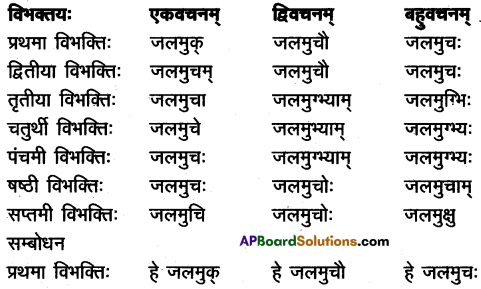
आ) पचत्
समाधान:
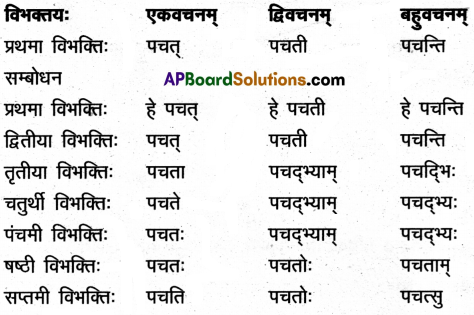
इ) मनस्
समाधान:
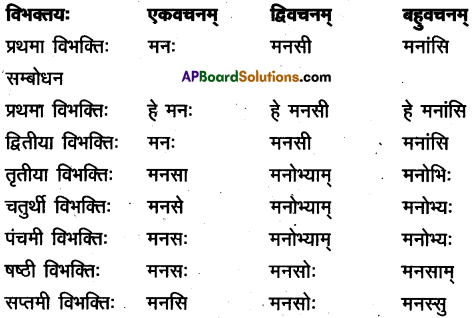
ई) यद् (पुं)
समाधान:
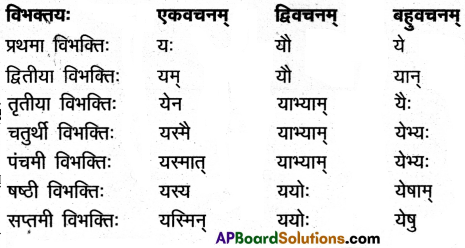
15. समासनामनिर्देशपूर्वकं त्रयाणां विग्रहवाक्यानि लिखत ।
अ) ईश्वराधीनम्
समाधान:
ईश्वरे अधीनम् = सप्तमीतत्पुरुष समासः
आ) मयूरव्यंसकाः
समाधान:
व्यंसकाः च ते मयूराः च = विशेषणपूर्वपदकर्मधारय समासः
इ) नवरात्रम्
समाधान:
नवानां रात्रीनां समाहारः = द्विगु समासः
ई) रामलक्ष्मणौ
समाधान:
रामः च लक्ष्मणः च = द्वन्द्व समासः
उ) प्रत्यक्षम्
समाधान:
अक्ष्णोः समीपे = अव्ययीभाव समासः
ऊ) नीलोज्वलवपुः
समाधान:
नीलं उज्वलं वपुः यस्य सः = बहुपदबहुव्रीहि समासः
![]()
16. अधो निर्दिष्ट पट्टिकामाधारीकृत्य पञ्चसाधुवाक्यानि लिखत ।
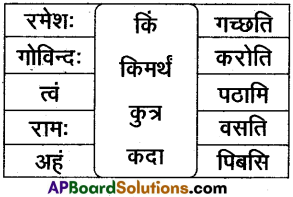
अ) प्रश्नाः
समाधान:
1. रमेशः किं रकोति ?
2. गोविन्दः किमर्थं वसति ?
3. त्वं कुत्र पिबसि ?
4. रामः कदा गरछति ?
5. अहं किं पठामि ?.